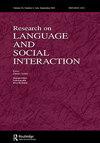对话是两个人的吗?社会互动的分割
IF 2.1
1区 文学
Q1 COMMUNICATION
引用次数: 13
摘要
谈话是灵活的,可以由不同数量的人进行,但大多数谈话是二元的。对话结构是否促进了二元焦点参与框架的流行?利用自发的自然对话的视频记录,我探索了多人互动,重点研究了轮流结构、顺序组织、讲故事和说话者凝视如何促进或抑制多人参与对话。正如我所展示的,因为我们的系统通过回合分配和顺序组织支持二元参与,维持焦点三方或多方参与框架比维持二元焦点参与框架需要更多的互动工作。然而,连续的双元参与,使双元不断变化,故事和笑话的讲述促进了多人的参与。虽然会话结构可以适应将焦点参与划分为二元或多方,但这些结构通常有利于二元焦点参与。数据是美式英语。本文章由计算机程序翻译,如有差异,请以英文原文为准。
Is Conversation Built for Two? The Partitioning of Social Interaction
ABSTRACT Conversation is flexible enough to be conducted with varying numbers of individuals, but most conversation is dyadic. Is the prevalence of dyadic focal participation frameworks facilitated by structures of conversation? Using video recordings of spontaneous naturally occurring conversations, I explore multiperson interactions focusing on how structures of turn taking, sequence organization, storytelling, and speaker gaze facilitate or inhibit the inclusion of multiple individuals in conversation. As I show, because our system favors dyadic participation through turn allocation and sequence organization, sustaining focal triadic or multiparty participation frameworks requires more interactional work than sustaining a dyadic focal participation framework. However, serially dyadic participation, which keeps dyads shifting, and story- and joke telling facilitate the participation of multiple individuals. Although conversational structures can be adapted to partition focal participation as dyadic or multiparty on a moment-by-moment basis, the structures generally facilitate dyadic focal participation. Data are in American English.
求助全文
通过发布文献求助,成功后即可免费获取论文全文。
去求助
来源期刊
CiteScore
7.30
自引率
7.40%
发文量
20
期刊介绍:
The journal publishes the highest quality empirical and theoretical research bearing on language as it is used in interaction. Researchers in communication, discourse analysis, conversation analysis, linguistic anthropology and ethnography are likely to be the most active contributors, but we welcome submission of articles from the broad range of interaction researchers. Published papers will normally involve the close analysis of naturally-occurring interaction. The journal is also open to theoretical essays, and to quantitative studies where these are tied closely to the results of naturalistic observation.

 求助内容:
求助内容: 应助结果提醒方式:
应助结果提醒方式:


